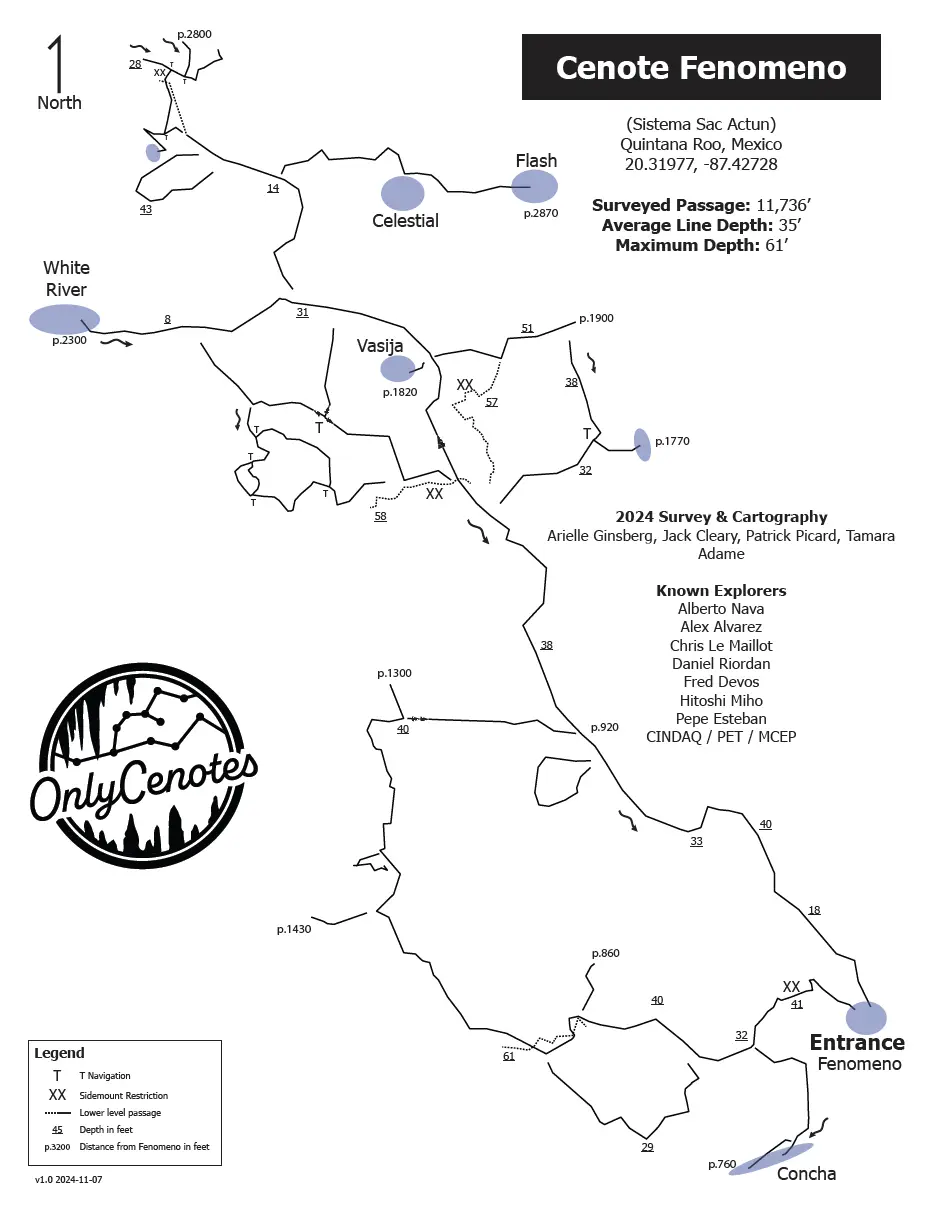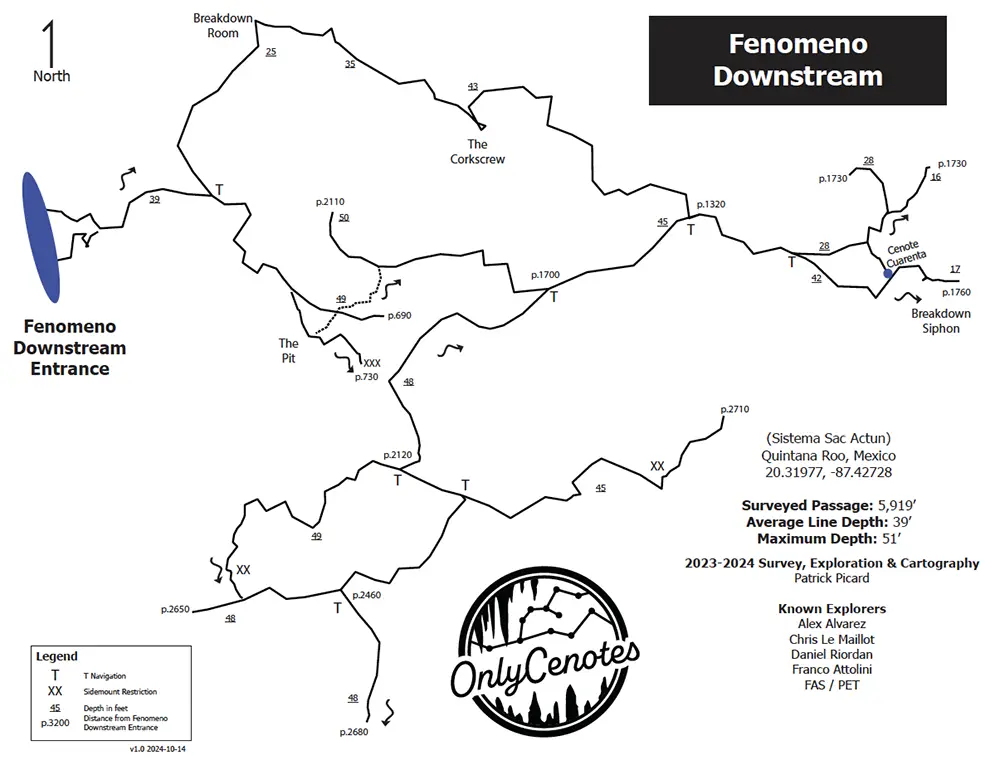The Pedrin Fenomeno Cenote is part of the huge underwater cave system Sac Actun—Dos Ojos—Nohoch Nah Chich.
Turning toward Pedrin Fenomeno Cenote into the jungle on the 54th kilometer from Playa del Carmen of the Cancun-Tulum federal road, you will find yourself on a country road. Following, the dusty, bumpy road leads deep into the jungle. It connects the entrances to a multitude of beautiful cenotes. Caracol, Chun Ya, Otoch Ha, Outland, La Concha, Pedrin Fenomeno, etc.
Cenote Pedrin Fenomeno is part of the connected system Sac Actun-Nohoch-Dos Ojos. Moreover, it is the world’s second-largest underwater cave system, with 376,7 km (234 miles) of underwater lines. The maximum depth is 119.18 mts (391 ft). The Nohoch historical section is an anchialine cave system connecting to naturally intruding marine water and tidal influence in the cenotes. However, this cave system’s coastal discharge point(s) has not yet been explored into the ocean. Despite this, dye tracing to flow towards Caleta Xel-Ha, a nearby coastal bedrock lagoon, demonstrated large volumes of groundwater.

The next world’s longest cave system, Ox Bel Ha, is very close — just a few kilometers south. So, perhaps shortly, a place will be discovered where these two cave systems connect. The combined cave system will be the largest underwater cave system in the world and the largest cave system in general, including dry caves.
Cenote dives in this area are available to certified cave divers who can go alone or are guided by a qualified cave instructor.
Pedrin Fenomeno cenote
Farther away in the forest, an 8km potholed dirt road leads to the Pedrin Fenomeno Cenote. Pedrin Fenomeno is one more half-collapsed sinkhole. Together with other nearby cenotes, it was part of the Actun Hu (don’t mess with Actun Ha) cave system, which now belongs to the Sac Actun-Nohoch-Dos Ojos cave system. Furthermore, the jungle atmosphere was overwhelming. There is a dilapidated bridge to enter the water. The stairs have collapsed, but you can enter the water on the right or left along the shore. You will come to a shady pond about 2-3 meters (6-10 feet) deep. Outside the cave were tall leafy trees, and beautiful “mot-mot” birds flew by.
The main line is just behind the rock, leading inside half-open cenote waters. After passing through several beautiful halls, the permanent line descends to 10 meters and remains at this depth until an unnamed cenote on the left, 600 meters (1800 feet) from the entrance. Visibility is always clear. You can jump left toward La Concha Cenote or continue straight forward.
On the way inside, you can discover an ancient vase on the left and megatherium (giant sloth) bones in a 17-meter (56 ft) deep pit on the right. At about 1200 meters distance from Cenote Pedrin Fenomeno entrance, you will arrive at the beautiful blue-colored waters of the White River Cenote, which you can pass forward following the line toward various T-intersections or jump to the right to the neighbor line leading to one more unnamed cenote in 1600 meters (1 mile) from the entrance.
Our Pedrin Fenomeno cenote cave diving video
La Concha – Fenomeno cenotes situation map

This map was published courtesy of OnlyCenotes.
Fenomeno cenote upstream area lines map

This map was published courtesy of OnlyCenotes.
Fenomeno cenote downstream area lines map

This map was published courtesy of OnlyCenotes.
Concha Siphon – Fenomeno South cenotes area lines map

This map was published courtesy of OnlyCenotes.
Pedrin Fenomeno Cenote location map
The first explorers were PET members Alex Alvarez, Franco Attolini, and Alberto Nava, who joined forces with MCEP/CINDAQ members Chris Le Maillot, Daniel Riordan, Fred Devos, and Sam Meacham to explore the Aktun Hu Cave System.
Explorations in Sistema Actun Hu began in January 2007. Explorers focused on La Concha, Pedrin Fenomeno, and upstream Cenote Chicomoztoc. About 8,000 ft (2,438 m) of passages were explored and surveyed, and a new, large cenote was located southeast of La Concha.
Robbie Schmittner connected Sistema Aktun Hu to the Nohoch Nah Chich region of Sistema Sac Actun on January 30, 2011
Back



